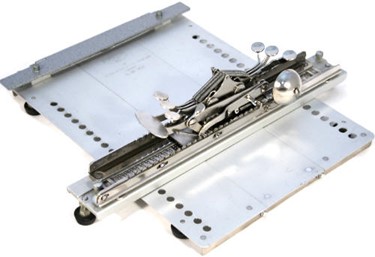
by Peter Claridge Bowler
Catching up on all things Braille, Peter Claridge Bowler in the Braille Support team has a look back in time at the Stainsby-Wayne Braille Typewriter.
The Stainsby braille typewriter
The Stainsby braille typewriter was first built in the 1880s and was still being built until the 1940, this was in following the RNIB’s adopting Louis Braille’s invention which was braille. This typewriter was to revolutionise the blind and visually impaired people wrote braille. It comprised of 6 keys that represented the braille cell and a mechanical cursor that went from right to left in order to type. It had a bell that would go off when you have only 7 spaces left in the page. It functions in a similar manner to the slate and stylus as you have to type from right to left, so you have to write backward so that when you take the paper out, you’ll be able to read it the correct way.
During its lifetime it went through a number of different changes and improvements. When it was first brought out the unit was built around a wooden plate that would be where you placed the paper. It had no auto advance so when you reached the end of the line you would have to manually move the paper up or down depending on what you were doing. That design feature never changed but it moved from wooden part and plates to metal ones which made the durability of it better. They also added an adjustable courser indicator which could be adjusted to the size of the paper that was in the writer. So you could change where the bell would ding to inform the individual how much space was left on the paper. So improvements were constant right up until end of production.
It was the first prolific device in order to write braille introduced to the general public, workplace, home, and education, it provided a wide range of opportunities to grain better educations, works and more.
This device also hold a personal interest to me as I first learnt braille on this old machine. Now before anyone says anything I’m not that old: I may act it but I’m not old. I had very close friends who were blind and still had the ones they were given as kids and they helped me learn braille.
Unfortunately, they went out of fashion as the invent of the Perkins Brailler came about: as the Perkins were not as difficult to operate and easier to learn, but this was one of the first major steps in braille writing.